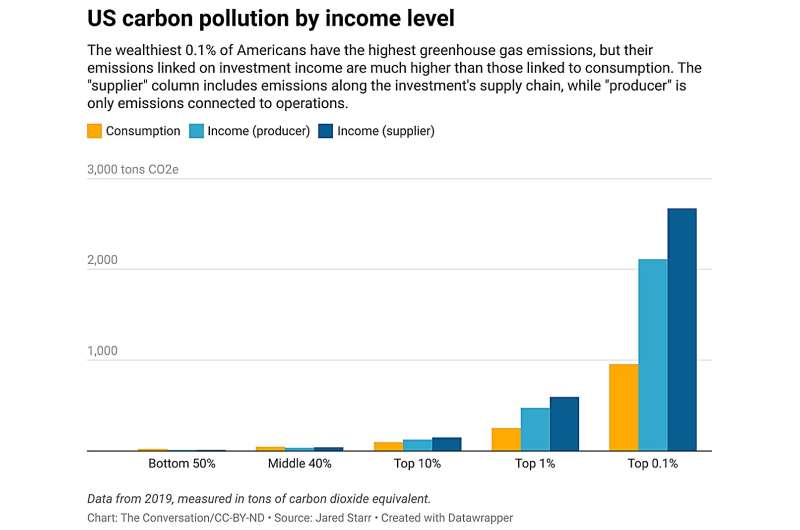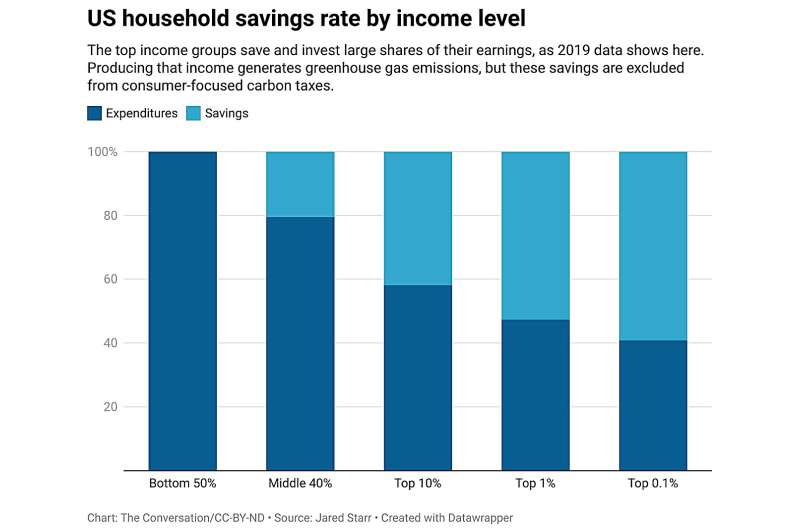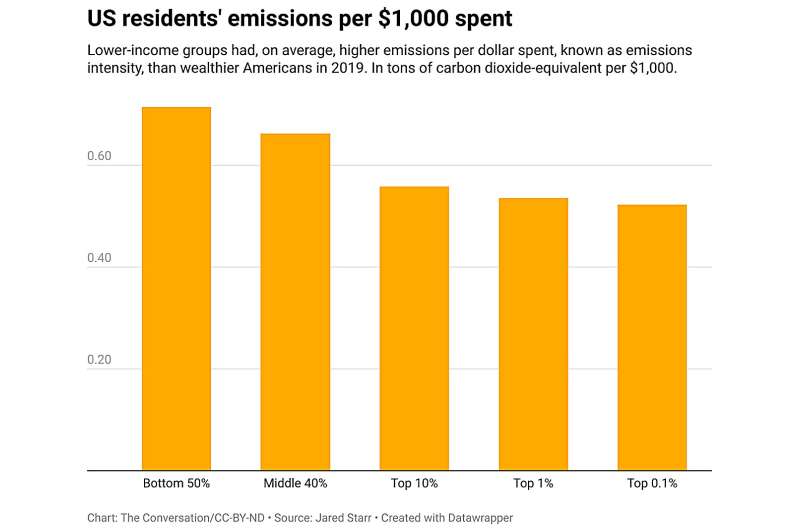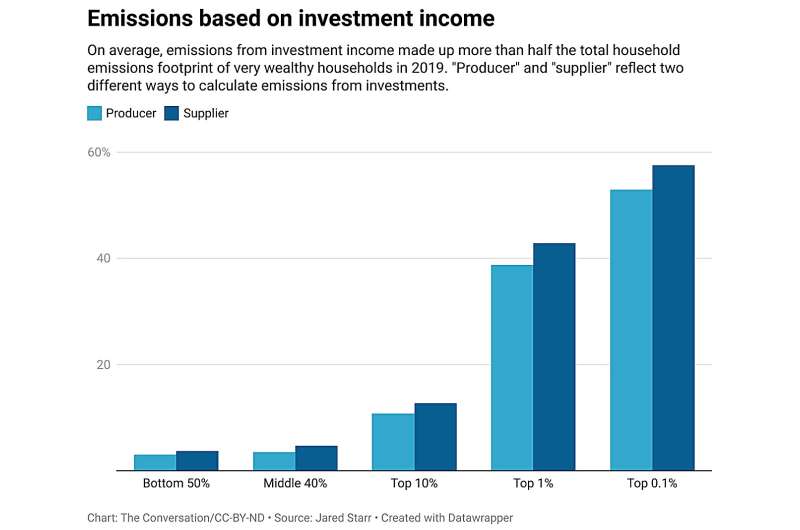This article has been reviewed according to Science X's editorial process and policies. Editors have highlighted the following attributes while ensuring the content's credibility:
fact-checked
trusted source
written by researcher(s)
proofread
A carbon tax on investment income could be more fair and make it less profitable to pollute, analysis finds

About 10 years ago, a very thick book written by a French economist became a surprising bestseller. It was called "Capital in the 21st Century." In it, Thomas Piketty traces the history of income and wealth inequality over the past couple of hundred years.
The book's insights struck a chord with people who felt a growing sense of economic inequality but didn't have the data to back it up. I was one of them. It made me wonder, how much carbon pollution is being generated to create wealth for a small group of extremely rich households? Two kids, 10 years and a Ph.D. later, I finally have some answers.
In a new study, colleagues and I investigated U.S. households' personal responsibility for greenhouse gas emissions from 1990 to 2019. We previously studied emissions tied to consumption—the stuff people buy. This time, we looked at emissions used in generating people's incomes, including investment income.
If you've ever thought about how oil company CEOs and shareholders get rich at the expense of the climate, then you've been thinking in an "income-responsibility" way.
While it may seem intuitive that those getting rich from fossil fuels bear responsibility for the emissions, very little research has been done to quantify this. Recent efforts have started to look at emissions related to household wages in France, global consumption and investments of different income groups and billionaires' investments. But no one has analyzed households across a whole country based on the emissions used to generate their full range of income, including wages, investments and retirement income, until now.
We linked a global data set of financial transactions and emissions to microdata from the U.S. Census Bureau and Bureau of Labor Statistics' monthly labor force survey, which includes respondents' job, demographics and income from 35 categories, including wages and investments. People's wages we connected to the emission intensity of the industries that employ them, and we based the emissions intensity of investment income on a portfolio that mirrors the overall economy.

The results of our analysis were eye-opening, and they could have profound implications for producing more effective and fair climate policies in the future.
A view from the top 1%
Both our consumption- and income-based approaches reveal that the highest-earning households are responsible for much more than an equitable share of carbon emissions. What's more surprising is how different the level of responsibility is depending on whether you look at consumption or income.
In the income-based approach, the share of national emissions coming from the top 1% of households is 15% to 17% of national emissions. That's about 2.5 times higher than their consumer-related emissions, which is about 6%.
In the bottom 50% of households, however, the trend is the exact opposite: Their share of consumption-based national emissions is 31%, about two times larger than their income-based emissions of 14%.
Why is that?

A couple things are going on here. First, the lowest earning 50% of U.S. households spend all that they earn, and often more via social assistance or debt. The top income groups, on the other hand, are able to save and reinvest more of their income.
Second, while high-income households have very high overall spending and emissions, the carbon intensity—tons of carbon dioxide emitted per dollar—of their purchases is actually lower than that of low-income households. This is because low-income households spend a large share of their income on carbon-intensive basic necessities, like home heating and transportation. High-income households spend more of their income on less-carbon-intensive services, like financial services or higher education.
Implications for a carbon tax
Our detailed comparison could help change how governments think about carbon taxes.
Typically, a carbon tax is applied to fossil fuels when they enter the economy. Coal, oil and gas producers then pass this tax on to consumers. More than two dozen countries have a carbon tax, and U.S. policymakers have proposed adding one in recent years. The idea is that raising the price of these products by taxing them will get consumers to shift to cheaper and presumably less carbon-intensive alternatives.
But our studies show that this kind of tax would disproportionately fall on poorer Americans. Even if a universal dividend check was adopted, consumer-facing carbon taxes have no impact on saved income. Generating that income likely contributed to greenhouse gas emissions, but as long as the money is used to buy stocks rather than consumables, it is excluded from carbon taxes. So, this kind of carbon tax disproportionately affects people whose income goes primarily toward consumption.

A profit-focused carbon tax
What if, instead of focusing on consumption, carbon taxes addressed greenhouse gases as an outcome of profit generation?
The vast majority of American corporations operate under the principle of "shareholder primacy," where they see a fiduciary duty to maximize profit for their investors. Products—and the greenhouse gases used to make them—are not created for the benefit of the consumer, but because the sale of those products will benefit the shareholders.
If carbon taxes were focused on shareholder income linked to greenhouse gas emissions rather than consumption, they could target those receiving the most economic benefits resulting from these emissions.
The impact
A couple of interesting things might result, particularly if the tax was set based on the carbon intensity of the company.
Corporate executives and boards would have incentive to reduce emissions to lower taxes for shareholders. Shareholders would have incentive, out of self-interest, to pressure companies to do so.
Investors would also have incentive to shift their portfolios to less-polluting companies to avoid the tax. Pension and private wealth fund managers would have incentive to divest from carbon-polluting investments out of a fiduciary duty to their clients. To keep the tax focused on large shareholders, I could see retirement accounts being excluded from the tax, or a minimum asset threshold before the tax applies.
Revenue generated from the carbon tax could help fund adaptation and the transition to clean energy.
Instead of putting the responsibility for cutting emissions on consumers, maybe policies should more directly tie that responsibility to corporate executives, board members and investors who have the most knowledge and power over their industries. Based on our analysis of the consumption and income benefits produced by greenhouse gas emissions, I believe a shareholder-based carbon tax is worth exploring.
Provided by The Conversation
This article is republished from The Conversation under a Creative Commons license. Read the original article.![]()





















